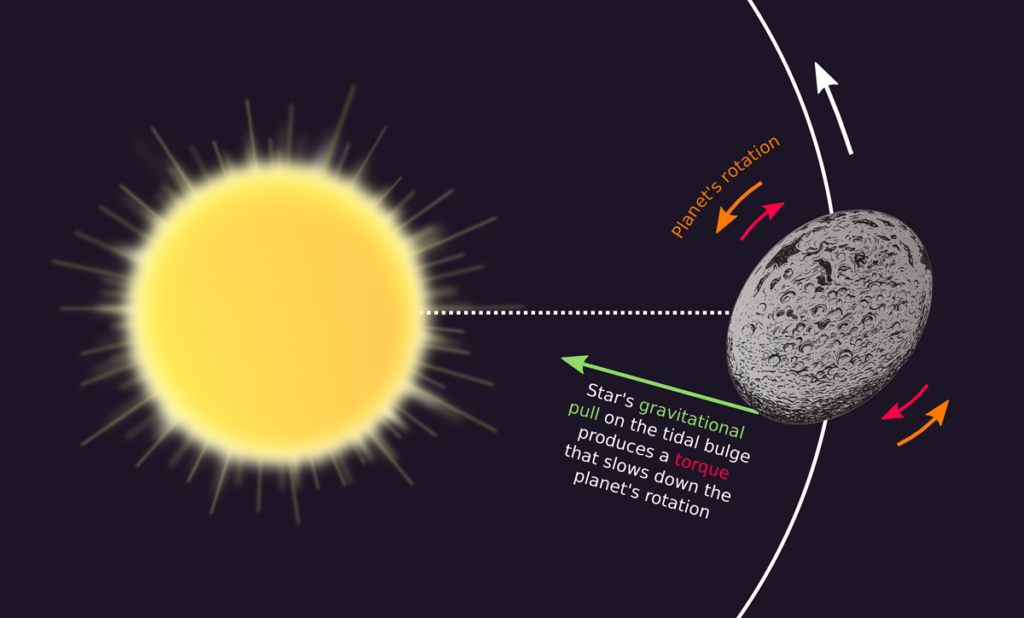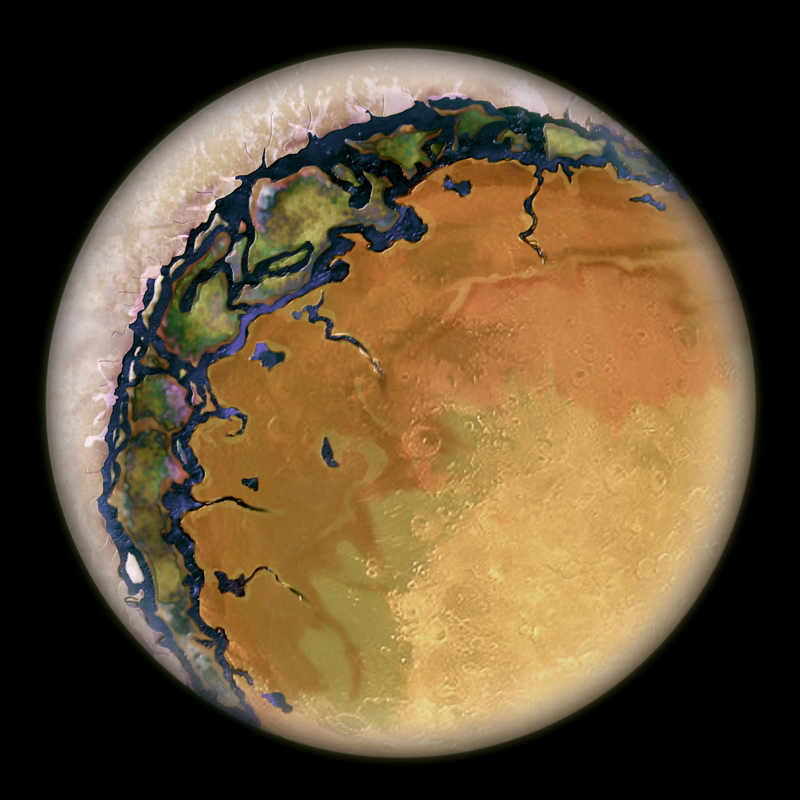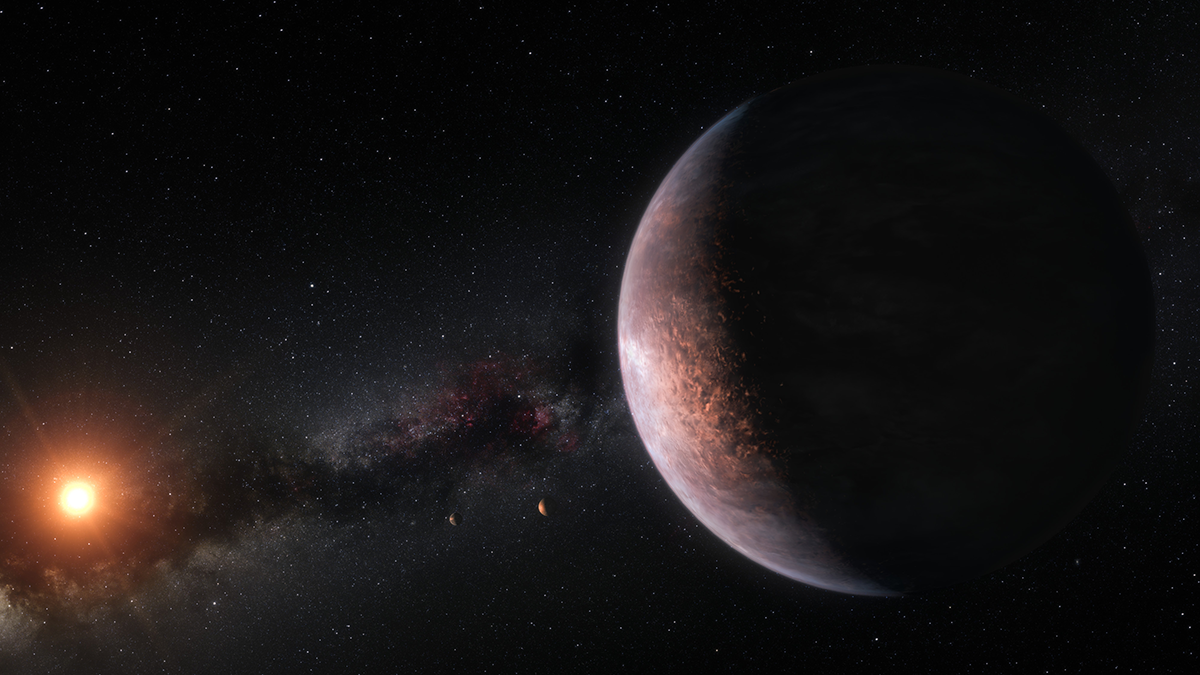In the past 20 years, astronomical observations have revealed thousands of planets outside our solar system. Some of these exoplanets are, at least by our standards on Earth, bizarre: Astronomers have found diamond planets; worlds whose surfaces are pelted by sapphires, rubies, and glass; and planets hotter than some stars. Outer space also harbors planets that are relatively similar to Earth, and excitement rises whenever a new “Earth-like” planet is discovered. Could there be life there? we wonder.
Rocky planets with stable orbits and long-lived host stars are potential targets in the search for extraterrestrial life. But as we look for habitable planets, there are other factors to consider, including whether a planet is tidally locked—that is, whether it always shows the same face to its host star. If so, one side of the planet could be burning hot while the other side is brutally cold. Would such a tidally locked exoplanet be able to support life? We don’t know, but the question raises another challenge for astronomers trying to characterize exoplanets and assess their habitability.
What Is Tidal Locking?
A tidally locked object rotates around its axis exactly once during its orbit around a host planet or star. This physical quirk affects many planets and moons, including Earth’s Moon. Because the Moon’s rotation and orbit around Earth both last a little less than a month, we always see the same craters and plateaus on the Moon’s surface while the opposite side is hidden from our sight.
This tidally locked state is a consequence of gravity. As the Moon orbits Earth, Earth’s gravity tugs at it. This force deforms the Moon, reshaping it from a perfect sphere into something a little more akin to an American football: slightly squashed at the poles, with a bulge at its equator facing Earth and another on its far side. The same sort of deformation manifests itself in Earth’s oceans, where the Moon’s tidal forces produce watery bulges that travel around Earth as it rotates, leading to alternating high and low tides.
Earth also has rocky tides that respond to the Moon’s pull, but solid rock is harder to deform than water, so the corresponding bulges aren’t as noticeable. Because rock bends and flows slowly, as the solid Earth rotates, its rocky tidal bulges pull ahead of the lunar gravitational force that causes them (Figure 1). This misalignment produces a torque on the Moon. Torques act on spinning bodies to slow or speed their rotation. When the Moon formed more than 4 billion years ago, it rotated more quickly than it does today, but over time, tidal torques slowed its rotation until it became tidally locked to Earth.

Other moons within our solar system are also tidally locked to their home planets, such as Jupiter’s moon Io and Saturn’s moon Enceladus. And Mercury, which rotates three times around its axis for every two revolutions around the Sun [Wieczorek et al., 2012], is almost tidally locked to the Sun. The only reason its rotational and orbital periods are slightly out of sync is that Mercury has a highly eccentric orbit (as opposed to the Moon, whose orbit around Earth is practically circular). Such processes likely occur between exoplanets and stars as well, turning planets that used to rotate faster into tidally locked satellites.
Hot and Cold
Tidal locking influences planetary bodies in dramatic ways that at a glance, do not paint a promising picture for the existence of life on these planets.
Tidal locking influences planetary bodies in dramatic ways that at a glance, do not paint a promising picture for the existence of life on these planets [Dole, 1970]. On a tidally locked planet, one side is always facing a star while the other is cloaked in perpetual darkness. The dark side could be so cold that water and would-be atmospheric components (e.g., carbon dioxide, nitrogen, or methane) are frozen, certainly an inhospitable environment for life as we know it. Indeed, the dark side could have lacked starlight—the main energy source for life on Earth—for billions of years, casting doubt on whether life could have ever emerged there.
On the planet’s bright side, the abundant light from its host star could be too much of a good thing: Extreme heat and stellar radiation can render a planet’s surface just as inhospitable as cold and darkness. Last but not least, tidal forces can heat a planet strongly enough to cause extreme volcanism, such as what occurs on Io. Explosive eruptions, lava flows, and clouds of sulfurous gas add up to a hostile environment that seems unlikely to harbor life.
A Common Phenomenon
Computer models suggest that many of the potentially habitable exoplanets we’re likely to discover may be tidally locked [Barnes, 2017]. This holds true especially for planets orbiting M dwarfs, the smallest and coolest type of star. M dwarfs are dimmer than the Sun, meaning surrounding planets must orbit closer to their M dwarfs to receive enough warmth to support liquid water at their surfaces and thus be considered habitable. But the closer a planet orbits its host star, the more likely it is to be tidally locked (recall that the gravitational force underlying tidal locking is stronger between objects that are close to each other) and thus perhaps uninhabitable considering the potentially extreme temperature dichotomies. Indeed, it’s expected that every planet in the habitable zone of an M dwarf will be tidally locked [Kasting et al., 1993].
Planets orbiting at greater distances from their host stars are harder to detect, which is why most exoplanets discovered so far—and many more we’re likely to discover in the near future—are on tight orbits.
Thus, the simple solution for missions seeking out habitable exoplanets might seemingly be to exclude M dwarfs and instead focus on larger stars that provide enough light and heat to far-out planets, which are less prone to tidal locking, for them to be habitable. Unfortunately, planets orbiting at greater distances from their host stars are harder to detect, which is why most exoplanets discovered so far—and many more we’re likely to discover in the near future—are on tight orbits.
So what does this mean in our search for habitable worlds? Close-in planets orbiting bright, hot host stars are likely to be scorched wastelands, like Mercury. On the other hand, if such a planet orbits a relatively cool M dwarf, there might be a chance that somewhere on its surface, it hosts a milder climate capable of supporting life.
In the Twilight Zone
As early as 1903, E. V. Heward suggested that between the night- and daysides of a tidally locked planet, “there must lie a wide zone of subdued rose-flushed twilight” [Heward, 1903]. This eternally twilit region could be warm enough to prevent water from freezing but cool enough that it doesn’t evaporate, forming a climatic “Goldilocks zone” where life could survive.

Such a planet could look something like an eye, with a hot, dry “pupil” on the side facing its host star that’s circled by a blue-green “iris,” indicating the presence of water and vegetation. There could also be icy eyelike planets whose surfaces are almost completely frozen, excepting a warm sea of meltwater facing the planet’s host star.
As numerical models of clouds and atmospheres improve, researchers are finding other mechanisms by which tidally locked planets could become habitable.
As numerical models of clouds and atmospheres improve, researchers are finding other mechanisms by which tidally locked planets could become habitable. If, for example, there were oceans on a planet’s surface, strong illumination on the dayside could evaporate the water and produce clouds. Clouds can act as climate stabilizers, forming above hot spots on a planet’s surface, where they reflect incoming starlight and thereby prevent the surface from heating even more [Yang et al., 2013].
Atmospheric heat distribution could also contribute to a milder climate. On tidally locked planets capable of retaining an atmosphere, winds could bring warm air from the dayside to the colder nightside and vice versa. This effect could be enhanced on planets with oceans. On Earth, circulating currents transport warm water and air from the Gulf of Mexico to northern Europe, whereas currents from the North and South Poles induce cold spells in Africa, South America, and Canada. Similar currents could reduce temperature contrasts between the day- and nightsides of tidally locked planets [Hu and Yang, 2013].
In addition, the motion of gases in an atmosphere could prevent a planet from becoming tidally locked at all. On the basis of calculations of gravitationally induced torquing, we would expect Venus to be locked to the Sun, but currents in Venus’s atmosphere counteract the tidal torques enough to keep it spinning. Analogous forces may be at work in exoplanet atmospheres too, meaning we may not always find tidal locking where we expect it [Leconte et al., 2015].
Finally, in specific cases, tidal forces can boost a planet’s habitability rather than diminish it. Jupiter’s moon Europa is not in the conventionally defined habitable zone: Its surface is cold and covered in a crust of shimmering ice. But the same tidal heating processes that cause magmatic eruptions on Io enable Europa to maintain a subsurface ocean of liquid water. Likewise, Enceladus has an ice-coated ocean that may contain hydrothermal vents. On Earth, such vents are chemically rich environments where microorganisms flourish. Because of their tidally heated oceans, Europa and Enceladus are promising targets for future missions searching for signs of life on other worlds. The same reasoning could be applied to icy exoplanets and their moons, including those eyelike worlds whose melted seas might be more likely to sustain life than the surrounding frozen wastelands.
A Boon, Not a Barrier
If we were to discount all planets in orbit around M dwarfs, our pool of potentially life harboring planetary bodies would be significantly reduced, and we might overlook many viable candidates.
The hypotheses for how tidally locked planets could still be habitable are ostensibly good news for scientists looking for life on exoplanets, especially because of the implications for exoplanets orbiting M dwarfs. If we were to discount all planets in orbit around M dwarfs because of the likelihood of tidal locking, our pool of potentially life harboring planetary bodies would be significantly reduced, and we might overlook many viable candidates. The revelation in 2017 that at least three of the seven terrestrial planets orbiting the cool dwarf star TRAPPIST-1 are in the habitable zone generated a lot of excitement (Figure 2). But at least several TRAPPIST-1 planets may be tidally locked. Should these worlds be ruled out for potential further exploration as a result?

The presence of strong temperature and irradiation contrasts and tidally driven heating and volcanism, as well as the absence of diurnal or seasonal cycles, on tidally locked planets suggests that if life does exist on these worlds, it must be resilient and adapted to significantly less balmy conditions than we are. Such resilience, although difficult to imagine, is within the realm of reality. After all, scientists continue to be surprised by the adaptability of Earth’s hardiest microbial inhabitants.
Tidal locking is therefore not a definite barrier to habitability. Ongoing study of the phenomenon and its implications for distant planets’ (and moons’) volcanism, composition, and climate will continue to shape our knowledge of planetary behavior, as well as the quest for planets that may be capable of supporting life.
References
Barnes, R. (2017), Tidal locking of habitable exoplanets, Celestial Mech. Dyn. Astron., 129, 509–536, https://doi.org/10.1007/s10569-017-9783-7.
Dole, S. (1970), Habitable Planets for Man, 2nd ed., Elsevier, New York.
Heward, E. (1903), Venus, Macmillan’s Mag., 88, 131–140, archive.org/details/macmillansmagazi88macmuoft/page/139/mode/1up.
Hu, Y., and J. Yang (2013), Role of ocean heat transport in climates of tidally locked exoplanets around M dwarf stars, Proc. Natl. Acad. Sci. U. S. A., 111, 629–634, https://doi.org/10.1073/pnas.1315215111.
Kasting, J. F., D. P. Whitmire, and R. T. Reynolds (1993), Habitable zones around main sequence stars, Icarus, 101(1), 108–128, https://doi.org/10.1006/icar.1993.1010.
Leconte, J., et al. (2015), Asynchronous rotation of Earth-mass planets in the habitable zone of lower-mass stars, Science, 347(6222), 632–635, https://doi.org/10.1126/science.1258686.
Wieczorek, M., et al. (2012), Mercury’s spin–orbit resonance explained by initial retrograde and subsequent synchronous rotation, Nat. Geosci., 5, 18–21, https://doi.org/10.1038/ngeo1350.
Yang, J., N. B. Cowan, and D. S. Abbot (2013), Stabilizing cloud feedback dramatically expands the habitable zone of tidally locked planets, Astrophys. J., 771(2), L45, https://doi.org/10.1088/2041-8205/771/2/l45.
Author Information
Caroline Hasler (@carbonbasedcary; [email protected]), ETH Zurich, Switzerland

